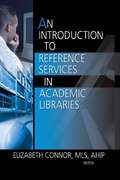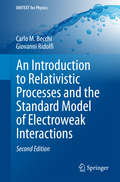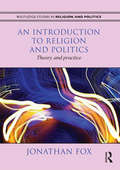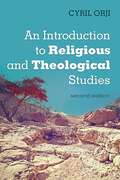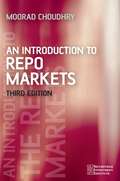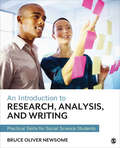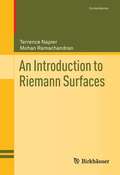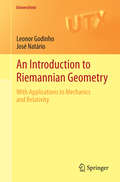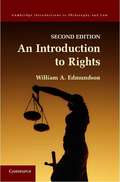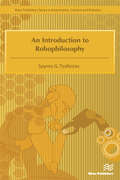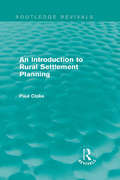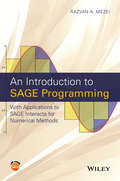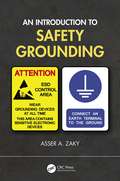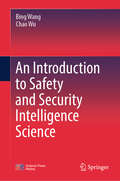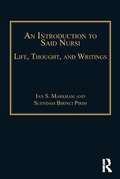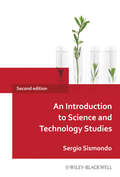- Table View
- List View
An Introduction to Reference Services in Academic Libraries
by Elizabeth ConnorAn introductory text on various aspects of reference services that requires your students to think!An Introduction to Reference Services in Academic Libraries is a comprehensive textbook that presents compelling case studies and thought-provoking essays that teach the principles of reference services. Eighteen authorities from private and public ac
An Introduction to Rehabilitation Engineering (ISSN)
by Hisaichi Ohnabe Douglas A. Hobson Rory A. CooperThis resource focuses on the principles, modeling, standards, devices, and technologies of rehabilitation engineering and assistive technology. It describes numerous design models and processes, including participatory action design and service delivery models. The book also discusses the components of devices such as cushions, wheelchairs, prostheses, orthoses, hearing aids, and TTYs. The contributors assess industry standards and explore innovative technology aids, such as sensors, robot-assisted therapy, and speech recognition software. The text contains a set of learning objectives and study questions in each chapter as well as a list of definitions at the end of the book.
An Introduction to Relativistic Processes and the Standard Model of Electroweak Interactions (UNITEXT for Physics)
by Carlo M. Becchi Giovanni RidolfiThis book offers a self-contained introduction to the theory of electroweak interactions based on the semi-classical approach to relativistic quantum field theory, with thorough discussion of key aspects of the field. The basic tools for the calculation of cross sections and decay rates in the context of relativistic quantum field theory are reviewed in a short, but complete and rigorous, presentation. Special attention is focused on relativistic scattering theory and on calculation of amplitude in the semi-classical approximation. The central part of the book is devoted to an illustration of the unified field theory of electromagnetic and weak interactions as a quantum field theory with spontaneously broken gauge invariance; particular emphasis is placed on experimental confirmations of the theory. The closing chapters address the most recent developments in electroweak phenomenology and provide an introduction to the theory and phenomenology of neutrino oscillations In this 2nd edition the discussion of relativistic scattering processes in the semi-classical approximation has been revised and as a result intermediate results are now explicitly proven. Furthermore, the recent discovery of the Higgs boson is now taken into account throughout the book. In particular, the Higgs decay channel into a pair of photons, which has played a crucial role in the discovery, is discussed. As in the first edition, the accent is still on the semi-classical approximation. However, in view of the necessity of a discussion of H !, the authors give several indications about corrections to the semiclassical approximation. Violation of unitarity is discussed in more detail, including the dispersion relations as a tool for computing loop corrections; the above-mentioned Higgs decay channel is illustrated by means of a full one-loop calculation; and finally, loop effects on the production of unstable particles (such as the Z0 boson) are now discussed. Finally, the neutrino mass and oscillation analysis is updated taking into account the major achievements of the last years.
An Introduction to Relativistic Quantum Field Theory
by Silvan S. Schweber"Complete, systematic, self-contained...the usefulness and scope of application of such a work is enormous...combines thorough knowledge with a high degree of didactic ability and a delightful style."--Mathematical ReviewsIn a relatively simple presentation that remains close to familiar concepts, this text for upper-level undergraduates and graduate students introduces the modern developments of quantum field theory. Starting with a review of the one-particle relativistic wave equations, it proceeds to a second-quantized description of a system of n particles, demonstrating the connection of this approach with the quantization of classical field theories. An examination of the restriction that symmetries impose on Lagrangians follows, along with a survey of their conservation laws. An analysis of simple models of field theories establishes the models’ content, and the problematic aspects of quantized field theories are explored.Succeeding chapters present the Feynman-Dyson perturbation treatment of relativistic field theories, including an account of renormalization theory, and the formulation of field theory in the Heisenberg picture is discussed at length. The book concludes with an account of the axiomatic formulation of field theory and an introduction to dispersion theoretic methods, in addition to a set of problems designed to acquaint readers with aspects of field theory not covered in the text.
An Introduction to Relativity
by Jayant V. NarlikarGeneral relativity is now an essential part of undergraduate and graduate courses in physics, astrophysics and applied mathematics. This simple, user-friendly introduction to relativity is ideal for a first course in the subject. Beginning with a comprehensive but simple review of special relativity, the book creates a framework from which to launch the ideas of general relativity. After describing the basic theory, it moves on to describe important applications to astrophysics, black hole physics, and cosmology. Several worked examples, and numerous figures and images, help students appreciate the underlying concepts. There are also 180 exercises which test and develop students' understanding of the subject. The textbook presents all the necessary information and discussion for an elementary approach to relativity. Password-protected solutions to the exercises are available to instructors at www. cambridge. org/9780521735612.
An Introduction to Religion and Politics: Theory and Practice
by Jonathan FoxAn Introduction to Religion and Politics offers a comprehensive overview of the many theories of religion and politics, and provides students with an accessible but in-depth account of the most significant debates, issues and methodologies. Fox examines the ways in which religion influences politics, analyses the current key issues and provides a state of the art account of religion and politics, highlighting the diversity in state religion policies around the world. Topics covered include: Secularism and secularization Religious identity Religious worldviews, beliefs, doctrines and theologies Religious legitimacy Religious institutions and mobilization Rational and functional religion Religious fundamentalism Conflict, violence and terror This work combines theoretical analysis with data on the religion policies of 177 governments, showing that while most of the world's government support religion and many restrict it; true neutrality on the issue of religion is extremely rare. Religion is becoming an inescapable issue in politics. This work will be essential reading for all students of religion and politics, and will also be of great interest to those studying related subjects such as comparative politics, international relations and war and conflict studies.
An Introduction to Religion and Politics: Theory and Practice (Routledge Studies in Religion and Politics)
by Jonathan FoxThis fully revised edition offers a comprehensive overview of the many theories of religion and politics and provides students with an accessible, in-depth guide to the subject’s most significant debates, issues, and methodologies. It begins by asking the basic questions of how social scientists see religion and why religion remains relevant to politics in the modern era. Fox examines the influence of religious identity, beliefs, institutions and legitimacy on politics, and surveys important approaches and issues found in the literature on religion and politics. Four new chapters on religious policy around the world, political secularism, and religious freedom and human rights have been added to fully revised content covering religious identity, rational choice approaches to religious politics worldviews, beliefs, doctrines, ideologies, institutions and political mobilization, fundamentalism, secularization, and religion and conflict. This work will be essential reading for all students of religion and politics, comparative politics, international relations, and security studies.
An Introduction to Religious and Theological Studies
by Cyril OrjiAn Introduction to Religious and Theological Studies walks students through topical issues to be encountered in the study of the Abrahamic religions: Judaism, Christianity, and Islam as these religions encounter other religions in the context of the wider ecumenism. The text is written from a Christian point of view and aims at helping students understand that to be Christian is to be ecumenical. African Traditional Religions (ATRs) has been included in this survey to provide background for the religious traditions and cultures of peoples of Africa as Christianity moves inexorably southward. The book has been written with undergraduate general education students in mind—including meeting the needs of those in seminaries and theological institutes.
An Introduction to Repo Markets
by Moorad ChoudhryThe Repo markets have grown dramatically in the past few years because of the need to hedge short positions in the capital and derivatives markets. Virtually all major currency markets in the world now have an established repo market, the facility is also increasingly being used in developing currency markets as well.This book is a practical introduction that focuses on the instruments, applications and risk management techniques essential for this rapidly evolving market. Fully updated to reflect the changes in these markets, the book also includes worked examples and case studies, and new sections on basket and structured finance repo.
An Introduction to Research in Counselling and Psychotherapy
by John McLeodIntroducing the basic principles of research theory and practice, this book is the ideal starter text for any counselling trainee or practitioner learning about the research process for the first time. Structured around common training topics, the book: - Explains why you need to do research at all: what it is, why it's important and its historical and philosophical context - Guides you through the confusing mass of research literature - Covers the ins and outs of actually doing research: practical and ethical issues - Helps you get the most out of research - how to evaluate the outcomes and use research to investigate the process of therapy. Written in a language familiar to first-year trainees and using a range of features to enhance learning, this accessible introduction will equip both trainees and qualified therapists with the essential nuts and bolts to understand research. John McLeod is Emeritus Professor of Counselling at the University of Abertay Dundee and adjunct Professor at the University of Oslo, Norway.
An Introduction to Research in Counselling and Psychotherapy (Professional Skills for Counsellors Series)
by John McleodIntroducing the basic principles of research theory and practice, this book is the ideal starter text for any counselling trainee or practitioner learning about the research process for the first time. Structured around common training topics, the book: - Explains why you need to do research at all: what it is, why it's important and its historical and philosophical context - Guides you through the confusing mass of research literature - Covers the ins and outs of actually doing research: practical and ethical issues - Helps you get the most out of research - how to evaluate the outcomes and use research to investigate the process of therapy. Written in a language familiar to first-year trainees and using a range of features to enhance learning, this accessible introduction will equip both trainees and qualified therapists with the essential nuts and bolts to understand research. John McLeod is Emeritus Professor of Counselling at the University of Abertay Dundee and adjunct Professor at the University of Oslo, Norway.
An Introduction to Research, Analysis, and Writing: Practical Skills for Social Science Students
by Bruce Oliver NewsomeThis accessible guide walks readers through the process of completing a social science research project. Written specifically to meet the needs of undergraduate research classes, it introduces students to a complete skill set, including: planning, design, analysis, argumentation, criticizing theories, building theories, modeling theories, choosing methods, gathering data, presenting evidence, and writing the final product. Students can use this text as a practical resource to navigate through each stage of the process, including choices between more advanced research techniques.
An Introduction to Research, Analysis, and Writing: Practical Skills for Social Science Students
by Bruce Oliver NewsomeThis accessible guide walks readers through the process of completing a social science research project. Written specifically to meet the needs of undergraduate research classes, it introduces students to a complete skill set, including: planning, design, analysis, argumentation, criticizing theories, building theories, modeling theories, choosing methods, gathering data, presenting evidence, and writing the final product. Students can use this text as a practical resource to navigate through each stage of the process, including choices between more advanced research techniques.
An Introduction to Reservoir Simulation Using MATLAB/GNU Octave: User Guide for the MATLAB Reservoir Simulation Toolbox (MRST)
by Knut-Andreas LieThis book provides a self-contained introduction to the simulation of flow and transport in porous media, written by a developer of numerical methods. The reader will learn how to implement reservoir simulation models and computational algorithms in a robust and efficient manner. The book contains a large number of numerical examples, all fully equipped with online code and data, allowing the reader to reproduce results, and use them as a starting point for their own work. All of the examples in the book are based on the MATLAB Reservoir Simulation Toolbox (MRST), an open-source toolbox popular popularity in both academic institutions and the petroleum industry. The book can also be seen as a user guide to the MRST software. It will prove invaluable for researchers, professionals and advanced students using reservoir simulation methods. This title is also available as Open Access on Cambridge Core.
An Introduction to Riemann Surfaces (Cornerstones)
by Mohan Ramachandran Terrence NapierThis textbook presents a unified approach to compact and noncompact Riemann surfaces from the point of view of the so-called L2 $\bar{\delta}$-method. This method is a powerful technique from the theory of several complex variables, and provides for a unique approach to the fundamentally different characteristics of compact and noncompact Riemann surfaces. The inclusion of continuing exercises running throughout the book, which lead to generalizations of the main theorems, as well as the exercises included in each chapter make this text ideal for a one- or two-semester graduate course.
An Introduction to Riemannian Geometry: With Applications to Mechanics and Relativity (Universitext)
by Leonor Godinho José NatárioUnlike many other texts on differential geometry, this textbook also offers interesting applications to geometric mechanics and general relativity. The first part is a concise and self-contained introduction to the basics of manifolds, differential forms, metrics and curvature. The second part studies applications to mechanics and relativity including the proofs of the Hawking and Penrose singularity theorems. It can be independently used for one-semester courses in either of these subjects. The main ideas are illustrated and further developed by numerous examples and over 300 exercises. Detailed solutions are provided for many of these exercises, making An Introduction to Riemannian Geometry ideal for self-study.
An Introduction to Rights
by William A. EdmundsonAn Introduction to Rights is a readable and accessible introduction to the history, logic, moral implications, and political tendencies of the idea of rights. It is organized chronologically and discusses important historical events such as the French and American Revolutions. It treats a range of historical figures, including Grotius, Paley, Hobbes, Locke, Bentham, Burke, Godwin, Douglass, Mill, and Hohfeld, and relates the concept of rights to contemporary debates such as consequentialism versus contractualism. This thoroughly updated second edition includes a new preface and expands the discussion of the surprising role that slavery has played in the history of rights. It includes new material on egalitarianism, distributive justice, and what the demand for equal rights means.
An Introduction to Robophilosophy Cognition, Intelligence, Autonomy, Consciousness, Conscience, and Ethics: Cognition, Intelligence, Autonomy, Consciousness, Conscience And Ethics (River Publishers Series In Automation, Control, And Robotics Is A Series Of Comprehensive Academic And Professional Books Which Focus On The Theory And Applications Of Automation, Control And Robotics. The Series Focuses On Topics Ranging From The Theory And Use Of Control Systems, Automation Engineering, Robotics And Intelligent Machines. Books Published In The Series Include Research Monographs,)
by Spyros G. TzafestasModern robots have arrived at a very matured state both in their mechanical / control aspects and their mental aspects. An Introduction to Robophilosophy explores the philosophical questions that arise in the development, creation, and use of mental – anthropomorphic and zoomorphic- robots that are capable of semiautonomous / autonomous operation, decision making and human-like action, being able to socially interact with humans and exhibit behavior similar to human beings or animals. Coverage first presents fundamental concepts, and an overview of philosophy, philosophy of science, and philosophy of technology. The six principal mental capabilities of modern robots, namely cognition, intelligence, autonomy, consciousness, conscience, and ethics are then studied from a philosophical point of view. They actually represent the product of technological embodiment of cognitive features to robots. Overall, readers are provided a consolidated thorough investigation of the philosophical aspects of these mental capabilities when embedded to robots. This book will serve as an ideal educational source in engineering and robotics courses as well as an introductory reference for researchers in the field of robotics, and it includes a rich bibliography.
An Introduction to Robust Combinatorial Optimization: Concepts, Models and Algorithms for Decision Making under Uncertainty (International Series in Operations Research & Management Science #361)
by Michael Hartisch Marc GoerigkThis book offers a self-contained introduction to the world of robust combinatorial optimization. It explores decision-making using the min-max and min-max regret criteria, while also delving into the two-stage and recoverable robust optimization paradigms. It begins by introducing readers to general results for interval, discrete, and budgeted uncertainty sets, and subsequently provides a comprehensive examination of specific combinatorial problems, including the selection, shortest path, spanning tree, assignment, knapsack, and traveling salesperson problems. The book equips both students and newcomers to the field with a grasp of the fundamental questions and ongoing advancements in robust optimization. Based on the authors’ years of teaching and refining numerous courses, it not only offers essential tools but also highlights the open questions that define this subject area.
An Introduction to Rural Settlement Planning (Routledge Revivals)
by Paul ClokeThis book, first published in 1983, provided the first thorough and informative introduction to the theory, practice and politics of rural settlement planning. It surveys the conceptual and ideological leanings of those who have developed, implemented and revised rural settlement practice, and gives detailed analysis of planning documentation to assess the extent to which policies have been successfully implemented. Paul Cloke assesses the shortfalls of rural planning and resource management and suggests methods by which a sustainable rural future might be attained. This reissue provides essential background and a comprehensive handbook for those with an interest in rural settlement planning.
An Introduction to SAGE Programming
by Razvan A. MezeiFeatures a simplified presentation of numerical methods by introducing and implementing SAGE programs An Introduction to SAGE Programming: With Applications to SAGE Interacts for Numerical Methods emphasizes how to implement numerical methods using SAGE Math and SAGE Interacts and also addresses the fundamentals of computer programming, including if statements, loops, functions, and interacts. The book also provides a unique introduction to SAGE and its computer algebra system capabilities, discusses second and higher order equations and estimate limits, and determines derivatives, integrals, and summations. Providing critical resources for developing successful interactive SAGE numerical computations, the book is accessible without delving into the mathematical rigor of numerical methods. The author illustrates the benefits of utilizing the SAGE language for calculus and the numerical analysis of various methods such as bisection methods, numerical integration, Taylor's expansions, and Newton's iterations. Providing an introduction to the terminology and concepts involved, An Introduction to SAGE Programming: With Applications to SAGE Interacts for Numerical Methods features: An introduction to computer programming using SAGE Many practical examples throughout to illustrate the application of SAGE Interacts for various numerical methods Discussions on how to use SAGE Interacts and SAGE Cloud in order to create mathematical demonstrations Numerous homework problems and exercises that allow readers to practice their programming skillset A companion website that includes related SAGE programming code and select solutions to the homework problems and exercises An Introduction to SAGE Programming: With Applications to SAGE Interacts for Numerical Methods is an ideal reference for applied mathematicians who need to employ SAGE for the study of numerical methods and analysis. The book is also an appropriate supplemental textbook for upper-undergraduate and graduate-level courses in numerical methods.
An Introduction to Safety Grounding
by Asser A. ZakySafety or protective grounding is of vital importance for the protection of individuals from electric shock and structures and industrial concerns from potentially damaging lightning and electrostatic discharges. To many electrical engineers the notion of grounding is nebulous and safety grounding is quite often confused with neutral grounding of the power supply. The main objective of this book is to give the reader a better understanding of safety grounding, why it is needed, where it is needed, and what are the requirements which must be met in order to have an effective grounding system. The text as a whole serves to provide the reader with the necessary background for a better appreciation of the various National and International Standards concerned with safety grounding. This book gives the reader a good understanding of the fundamentals of safety grounding. It is a practical guide that provides a comprehensive coverage of all types of grounding requirements and is intended for students and practicing electrical engineers alike. Summarizes the physiological effects of current on the human body and the effect of current duration Gives the various methods of measuring soil resistivity and measuring the resistance to ground of an electrode or grounding system Reviews different types of ground electrodes and the effect of their geometry and numbers on the resistance to ground Presents the components of a ground system, methods of improving soil resistivity, the types of welds and joints, the criteria for determining conductor cross-sections, galvanic corrosion, and a survey of the different grounding practices used at substations and the different types of grounding systems used for the protection of consumers Deals with electrostatic and lightning hazards that can cause serious damage and the measures used to protect against such damage Throughout the text frequent reference is made to various National and International Standards and their requirements as compliance with these standards is highly advised Asser A. Zaky, Ph.D., FIET, F.Inst.P., FIEEE, is Emeritus Professor of Electrical Engineering at University of Alexandria, Egypt.
An Introduction to Safety and Security Intelligence Science
by Bing Wang Chao WuThis book is dedicated to the introduction and research on safety and security intelligence science. It is the first time to put forward the idea of intelligence-led safety management, which demonstrates distinct interdisciplinary characteristics. It caters to the needs of safety and safety intelligence in the era of big security and big intelligence, and enhances the academic value of safety intelligence research. Whether you are engaged in practical work or scientific research on safety and intelligence, or are interested in issues about safety and intelligence, this academic book will prove to be a worthy collection.
An Introduction to Said Nursi: Life, Thought, and Writings
by Ian S. Markham Suendam Birinci PirimContemporary Islamic thinkers are often studied sociologically rather than as theologians. There are many accessible introductions to Christian theologians, but very few such studies of Islamic thinkers. This book, and this series, seeks to change this situation: offering new introductions to influential Islamic thinkers and engaging, at the level of ideas, with the rich depths of contemporary Islamic theology. This book introduces to the English-speaking world the leading modern Islamic thinker Said Nursi (1878-1960) - who has some nine million followers in modern day Turkey and around the world. After an opening chapter that provides an overview of his life, the next four chapters outline the theology of Nursi on God, the Qur'an, the West and Politics. The final section provides an invaluable resource of readings from Nursi's most important writings. Providing an introduction to a major form of Islam which is committed to non-violence, dialogue and constructive relationships with the West, this is the first student textbook to introduce a contemporary Islamic theologian in a systematic way.
An Introduction to Science and Technology Studies
by Sergio SismondoAn Introduction to Science and Technology Studies, Second Edition reflects the latest advances in the field while continuing to provide students with a road map to the complex interdisciplinary terrain of science and technology studies. Distinctive in its attention to both the underlying philosophical and sociological aspects of science and technologyExplores core topics such as realism and social construction, discourse and rhetoric, objectivity, and the public understanding of science Includes numerous empirical studies and illustrative examples to elucidate the topics discussedNow includes new material on political economies of scientific and technological knowledge, and democratizing technical decisionsOther features of the new edition include improved readability, updated references, chapter reorganization, and more material on medicine and technology
